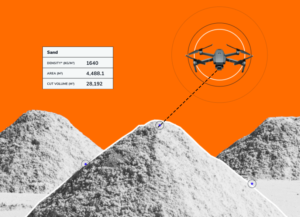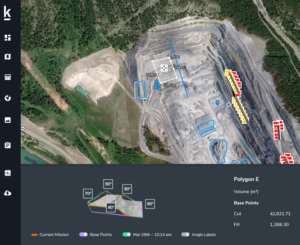Advances in machine learning, Ai, data management, and cloud computing are having a significant impact on the market for drone-based mapping and intelligence gathering. Even as satellite-based imaging gains steam, drones appear to be extending their lead closer to Earth.
We are in the midst of a renaissance in drone-based aerial intelligence. From counting the number of koalas in the Australian outback to detecting enemy combatants inside of buildings, drones seem to be everywhere at the moment.
The surge in drone use is great news for Krishnan Hariharan, the CEO of Kespry, a 30-person California drone AI startup. Kespry supplies the Ai software that mining outfits, insurance firms, and waste management companies use to turn a small, unmanned aircraft into an information collection powerhouse.
Instead of sending inspectors up onto ladders to look at roofs, or forcing them to climb giant piles of dirt or descend into large pits, Kespry enables a customer with an iPad to draw a route, launch the drone, and get accurate representations of roofing damage or aggregate volumes in just a matter of minutes.
Technological advances are driving this surge in drone-based mapping and Ai, Hariharan says.
“It was a lot harder” five years ago, he tells Datanami. “I don’t really see much of a technology boundary. Drones are getting smarter, models are getting better, data is a lot easier to process, and GIS location data is more readily available.”

Every time a large tornado or hurricane causes damage to homes in the United States, you can bet that Kespry’s customer, State Farm, will be using drones to surveil the damage. According to Hariharan, the combination of Kespry’s Ai software and a standard drone can cut the inspection time by a factor of 10.
“If it’s something that normally takes a couple of days, we do it in about two hours,” Hariharan says. “It removes the manual effort and creates efficiency, number one. Two is safety. Some of these pits are huge. From a safety standpoint, flying a drone and collecting data is a lot [safer] than climbing it and doing it old school.”
When it started nearly a decade ago, Kespry built drones on behalf of customers. But today, the company is focused on developing the Ai software that enables the raw images and videos collected by drones to be turned into actionable information.
Machine learning models and Ai are used to prepare the data for analysis, and are used for the analysis itself, according to Hariharan. Ai is used for everything from stitching images together and accounting for vegetation that can complicated volumetrics calculation to calculating the angles of roofs and identifying wind and hail damage. “We have to do pixel-level accuracy,” he says.
Kespry uses a mix of different Ai technologies and deep learning frameworks to build its system, including TensorFlow and PyTorch, Hariharan says. It uses cloud services like Amazon SageMaker and Azure ML Services, and other offerings. While customers could build their own Ai system to process drone data, Hariharan says they should be prepared to address more complexity than they may be prepared for.

“You can always take an open-source library and create a baseline model in a couple of weeks. If you know what you’re doing, you can do it in a matter of days,” he says. “But then the question is about the data it collects. What people misunderstand and underestimate when customers start building software like this is the GIS dataset that’s required to start creating these 2D and 3D models and do all this analysis. It’s not so much about taking images and identifying. The moment you start creating 2D and 3D models, the game has totally changed.”
For example, a customer that wants to implement a drone-based Ai system for utility pole inspection has to take numerous things into account, Hariharan says.
“When you create 2D and 3D models around it, that’s when it becomes complex because they need to take into account XYZ coordinates,” he says. “They need to consider the wind pattern, and the overlap of the images, pixel-by-pixel mapping. These are things customers are not able to implement, or they underestimate when they take on some of these projects. That’s what we have been doing.”
With eight years of experience in building these types of models, Kespry has a head start that customers will be challenged to match. The company built its platform such that it can easily plug in new Ai frameworks if a new one appears that is better suited for the mission at hand.
“We do a lot of plumbing work right now so that we can pull in any model we need,” Hariharan said. “If there’s a third-party model that is better than us, we can just pull it in. I’d rather just take that third-party model and pull it in. It’s not all about us owning [the technology]. We’re building it in a way that that we provide value for the customer.”
The story around synthetic data is similar. While real image data would be ideal for training Kespry’s machine learning models on, there may be a lack of large amounts of data for certain objects.
“We’re using synthetic data to leapfrog the data requirements,” Hariharan says. “We’re working with a couple of companies that we use to create synthetic data on top of the actual data, to make sure that our models are a lot more accurate from the day it is released.”
The future of drones is bright, particularly as companies like Kespry bring Ai to bear on the images drones can collect. As the Ai gets even better over the coming years, you can expect to see more drones extracting more useful information from the Earth sitting just a few feet below.
Original article with Datamani
You can learn more about Kespry at kespry.com
